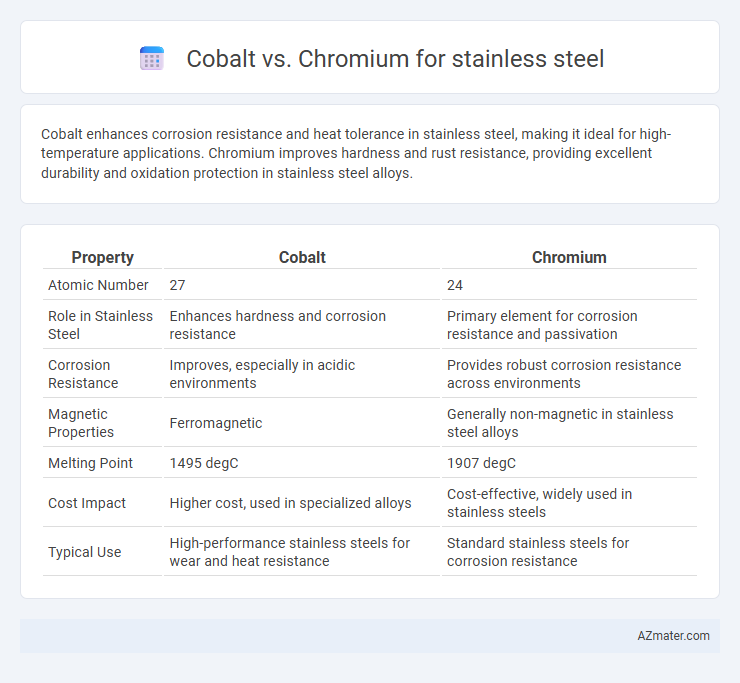Cobalt enhances corrosion resistance and heat tolerance in stainless steel, making it ideal for high-temperature applications. Chromium improves hardness and rust resistance, providing excellent durability and oxidation protection in stainless steel alloys.
Table of Comparison
| Property | Cobalt | Chromium |
|---|---|---|
| Atomic Number | 27 | 24 |
| Role in Stainless Steel | Enhances hardness and corrosion resistance | Primary element for corrosion resistance and passivation |
| Corrosion Resistance | Improves, especially in acidic environments | Provides robust corrosion resistance across environments |
| Magnetic Properties | Ferromagnetic | Generally non-magnetic in stainless steel alloys |
| Melting Point | 1495 degC | 1907 degC |
| Cost Impact | Higher cost, used in specialized alloys | Cost-effective, widely used in stainless steels |
| Typical Use | High-performance stainless steels for wear and heat resistance | Standard stainless steels for corrosion resistance |
Introduction to Stainless Steel Alloys
Stainless steel alloys primarily consist of iron, chromium, and varying amounts of carbon, with chromium providing corrosion resistance and hardness. Cobalt is occasionally added to enhance high-temperature strength and wear resistance, particularly in specialized stainless steel grades. Chromium content typically ranges from 10.5% to 30%, forming a passive oxide layer that prevents rust, while cobalt additions improve mechanical properties without significantly altering corrosion resistance.
Overview of Cobalt and Chromium Elements
Cobalt and chromium are essential elements in stainless steel, with chromium providing corrosion resistance and forming a passive oxide layer that protects the metal surface. Cobalt contributes to enhanced strength, wear resistance, and heat resistance, making it valuable in high-performance stainless steel alloys. The key difference lies in chromium's primary role in corrosion protection, while cobalt mainly improves mechanical properties and thermal stability.
Roles of Cobalt in Stainless Steel
Cobalt in stainless steel enhances high-temperature strength and corrosion resistance, making it essential for heat-resistant alloys. It improves the alloy's ability to retain hardness and structural integrity under extreme conditions, beneficial in aerospace and power generation applications. Unlike chromium, which primarily provides corrosion and oxidation resistance, cobalt contributes to improving mechanical properties and durability at elevated temperatures.
Functions of Chromium in Stainless Steel
Chromium is a critical element in stainless steel, providing corrosion resistance by forming a passive oxide layer that protects the metal from rust and oxidation. Its presence improves hardness, wear resistance, and enhances the steel's ability to withstand high temperatures. Unlike cobalt, which primarily increases strength and magnetic properties, chromium directly contributes to the stainless steel's durability and longevity in harsh environments.
Corrosion Resistance: Cobalt vs Chromium
Chromium significantly enhances stainless steel's corrosion resistance by forming a stable, passive oxide layer that prevents rust and chemical attack. Cobalt contributes to corrosion resistance primarily by improving alloy stability and strength at high temperatures but does not form a protective oxide layer like chromium. For superior corrosion resistance in stainless steel, chromium content remains the critical factor, often ranging from 10.5% to 30% depending on steel grade.
Mechanical Properties Comparison
Cobalt enhances stainless steel's mechanical properties by significantly improving hardness, tensile strength, and wear resistance, making it ideal for high-stress applications. Chromium contributes to corrosion resistance and oxidation resistance while also increasing hardness and tensile strength, but typically offers lower toughness compared to cobalt alloys. The combination of cobalt in stainless steel alloys results in superior impact resistance and fatigue strength, outperforming chromium-dominant formulations in demanding mechanical environments.
Impact on Heat Resistance
Cobalt significantly enhances the heat resistance of stainless steel by stabilizing the austenitic phase, allowing the alloy to maintain strength and oxidation resistance at elevated temperatures above 600degC. Chromium contributes primarily to corrosion resistance and forms a protective oxide layer but offers limited improvement in high-temperature mechanical properties. Stainless steels with higher cobalt content are preferred for applications requiring sustained performance in extreme heat, such as turbine blades and heat exchangers.
Cost and Availability Analysis
Cobalt is significantly more expensive than chromium due to its scarcer global reserves and complex extraction process, impacting the cost structure of stainless steel alloys. Chromium is widely available with abundant deposits worldwide, making it a cost-effective choice for stainless steel production. Supply chain stability and market demand favor chromium, ensuring steady availability and lower price volatility compared to cobalt.
Applications in Industry
Cobalt enhances stainless steel's heat resistance, making it ideal for aerospace turbine components and cutting tools. Chromium provides excellent corrosion resistance, widely used in kitchenware, medical instruments, and structural frameworks. Industries requiring durability in high-temperature environments prefer cobalt-alloyed stainless steel, whereas chromium-rich stainless steel suits applications exposed to moisture and chemicals.
Environmental and Health Considerations
Cobalt in stainless steel poses significant environmental concerns due to its toxicity and potential bioaccumulation, impacting aquatic life and human health through prolonged exposure. Chromium, particularly hexavalent chromium, is a well-known carcinogen and can cause severe respiratory issues, but its trivalent form used in stainless steel is generally safer and essential for corrosion resistance. Both metals require careful handling and disposal to minimize ecological damage, emphasizing the importance of regulatory compliance and sustainable recycling practices.

Infographic: Cobalt vs Chromium for Stainless steel
 azmater.com
azmater.com